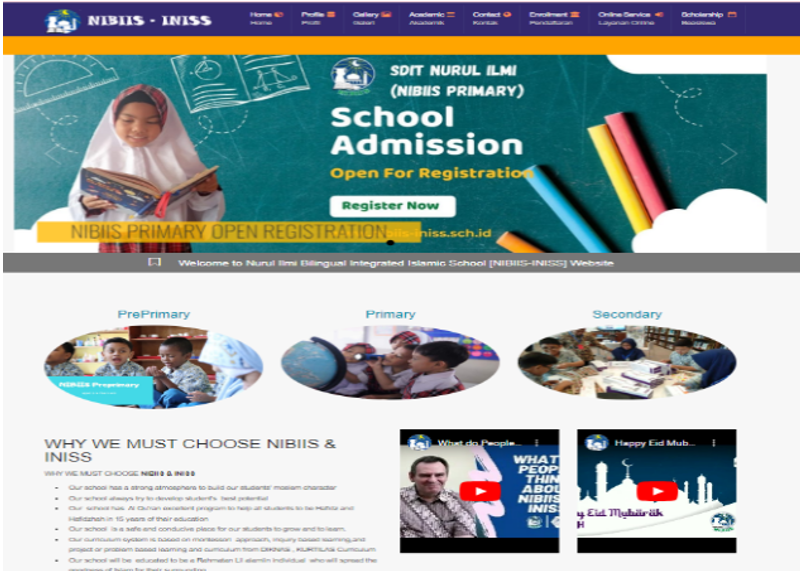PERANCANGAN ULANG UI/UX WEBSITE SDIT NURUL ILMI BILIGUAL INTEGRATED SCHOOL BEKASI MENGGUNAKAN METODE DESIGN THINKING
DOI:
https://doi.org/10.31949/infotech.v10i2.11736Abstract
ABSTRACT
SDIT Nurul Ilmi Bilingual School Integrated Bekasi is one of the educational institutions that utilizes the advancement of technology and the internet that is currently growing by providing a school website that contains several features such as online new student admissions and e-reports along with other information. The lack of information available regarding new student admissions, academic information, and school programs available on the school website owned by SDIT Nurul Ilmi Bilingual School Integrated Bekasi makes users dissatisfied in using the website. The redesign of this website uses the design thinking method which is a human-centered design approach to understand user needs and problems and create new innovations. The results of the prototype testing using Maze as a whole were 96%, which means that the prototype design that was tested can work well and is easy to understand by users. The results of usability testing on the prototype obtained an average score of 88 which showed excellent results with a grade scale of B, which means that the system is declared feasible. The results of the redesign in the form of a prototype can be used by related parties, namely website developers.
Keywords: User interface, User Experience, Design Thinking
Abstrak
SDIT Nurul Ilmi Bilingual School Integrated Bekasi merupakan salah satu lembaga pendidikan yang memanfaatkan kemajuan teknologi dan internet yang semakin berkembang saat ini dengan menyediakan website sekolah yang di dalamnya terdapat beberapa fitur seperti penerimaan siswa baru secara online dan e-raport beserta informasi-informasi lainnya. Minimnya informasi yang tersedia mengenai penerimaan siswa baru, informasi akademik, dan program sekolah yang tersedia pada website sekolah yang dimiliki SDIT Nurul Ilmi Bilingual School Integrated Bekasi membuat user belum puas dalam menggunakan website tersebut. Perancangan ulang webstite ini menggunakan metode design thinking yang merupakan pendekatan desain berpusat pada manusia untuk memahami kebutuhan dan masalah pengguna serta menciptakan inovasi baru. Hasil testing prototype menggunakan Maze secara keseluruhan sebesar 96% yang artinya desain prototype yang diuji dapat bekerja dengan baik dan mudah dipahami oleh pengguna. Hasil usability testing pada prototype memperoleh nilai rata-rata 88 yang menunjukan hasil excellent dengan grade scale B yang artinya sistem dinyatakan layak. Hasil re-design yang berupa prototype ini dapat digunakan pihak terkait yakni pengembang website.
Kata Kunci: User interface, User Experience, Design Thinking
Keywords:
design thinking, User Interface, User ExperienceDownloads
References
Ansori, S., Hendradi, P., & Nugroho, S. (2023). Penerapan Metode Design Thinking dalam Perancangan UI/UX Aplikasi Mobile SIPROPMAWA. Journal of Information System Research (JOSH), 4(4), 1072–1081. https://doi.org/10.47065/josh.v4i4.3648
Fariyanto, F., Suaidah, & Ulum, F. (2021). Perancangan Aplikasi Pemilihan Kepala Desa Dengan Metode Ux Design Thinking (Studi Kasus: Kampung Kuripan). Jurnal Teknologi Dan Sistem Informasi (JTSI), 2(2), 52–60. http://jim.teknokrat.ac.id/index.php/JTSI
Hawari Hisyam, Musnansyah Ahmad, & Al Anshary Faishal Mufied. (2023). Perancangan Ulang UI/UX Website Pengolahan Sampah Menggunakan Metode Design Thinking (Startup XYZ) . Jatisi, 10(1), 432–446.
Herfandi, H., Yuliadi, Y., Zaen, M. T. A., Hamdani, F., & Safira, A. M. (2022). Penerapan Metode Design Thinking Dalam Pengembangan UI dan UX. Building of Informatics, Technology and Science (BITS), 4(1), 337–344. https://doi.org/10.47065/bits.v4i1.1716
Informasi, S., Blimbing, K., Pandanwangi, K., & Malang, K. (2021). Analisis Website STIMATA Menggunakan System Usability Scale (SUS). Jurnal Ilmiah Komputasi, 20(3), 331–338. https://doi.org/10.32409/jikstik.20.3.2776
Pandusarani, G., Brata, A. H., & Jonemoro, E. M. A. (2018). Analisis User Experience Pada Game CS:GO dengan Menggunakan Metode Cognitive Walkthrough dan Metode Heuristic Evaluation. Jurnal Pengembangan Teknologi Informasi Dan Ilmu Komputer, 2(3), 940–950. https://j-ptiik.ub.ac.id/index.php/j-ptiik/article/view/1017

Published
How to Cite
Issue
Section
License
Copyright (c) 2024 Andreas Eka Pradana, Ika Kurniawati, Fachri Amsury, Heriyanto Heriyanto

This work is licensed under a Creative Commons Attribution-ShareAlike 4.0 International License.








